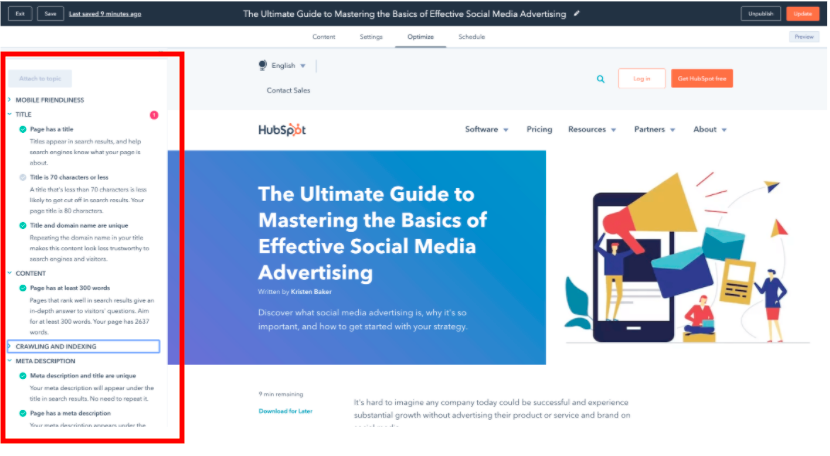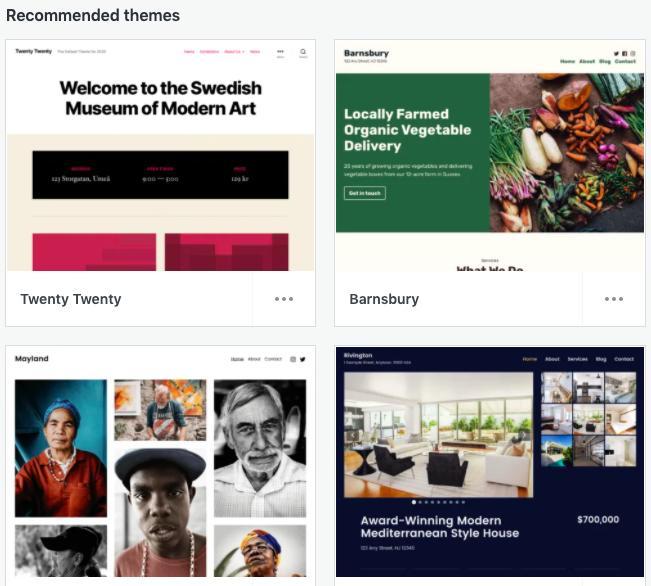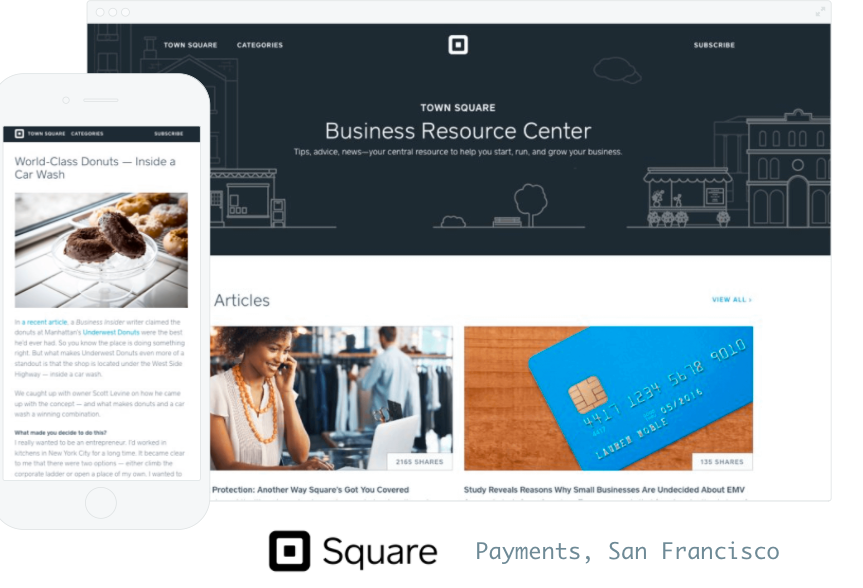When I sit down to write a blog post, I stick to a routine that has some flexibility.
The way I write changes from time to time, but two things never change: who I’m writing for, and how to deliver the best experience.
When you sit down to write, what are some of the questions you ask yourself? Are you keeping your audience in mind?
For example, if you are writing for enterprise audiences, how are you framing that content to achieve your goals? If you’re writing for the professional who is part of a large organization, how does your blog cater to their needs?
Though an enterprise audience is a smaller number of people to reach, blogging for those customers can be a huge driver for ROI and acquisition.
Many marketers agree — blogging is an important part of their content strategy.
Blogging does way more than populate your website with content. Did you know that B2B marketers obtain over 70% of their leads from blogging? Or that businesses that prioritize blogging are 13x more likely to see a positive ROI?
When you blog for customers, you’re not only providing useful content. Properly optimized posts lead to an increase in brand awareness and conversions.
Enterprise customers have their own set of unique needs and challenges, separate from customers in a startup. Your blog can assist with these needs, like how to manage a positive scale within a company.
However, a successful enterprise blog stems from having a successful strategy. Implementing a process for writing makes your content stick to business goals.
1. Come up with the purpose of your enterprise blog.
The good foundation of any strategy is to define the purpose of your goal. So, think about why your blog is going to exist. Are you aiming to build brand awareness and increase conversions?
Content that serves a purpose is easier to write because it has a focus. For instance, if the reason for starting your blog is to increase the number of enterprise leads you earn, all of your content should support this goal.
Having a clear purpose will also help you fill in some of the blanks for the rest of your blogging strategy, like distribution and topic research. To get started defining your blog’s purpose, think about the goals of your company and identify how your blog can contribute.
For instance, if one of your goals is to bridge the gap between the awareness and delight stages for leads, think about how you can create content that gets customers thinking about the value of your company on a deeper level. Blog posts can be highly engaging vehicles to entertain and inform the reader, and with the addition of widgets like calls-to-action, offer your customers more ways to familiarize themselves with your company.
Once you identify the purpose of your blog, you can finalize a goal that will allow you to create content that reaches them.
2. Determine your persona.
Your business already has a buyer persona — a fictionalized idea of the perfect customer. Keep that customer in mind when you’re writing. If it’s appropriate, you might want to come up with an entirely different persona, one that’s solely based around your enterprise audience.
If you’re creating a persona from scratch, ask yourself what your enterprise customer will find the most useful about your blog. What stage in the buyer’s journey do you want to target with your content, and how will a blog help you get there?
When you have a persona to reference for your blog content, you’ll have an idea of how to put yourself in the customer’s shoes and focus on writing that’s going to serve them the best.
For example, let’s say you create a persona called “Enterprise Ernie.” When you created Ernie, you identified challenges and pain points that keep him from doing his job better, like roadblocks that come up from being a marketing team manager for an enterprise.
When you create content, then, you can focus on how to help Ernie be a more effective marketing team manager. You’ll brainstorm topics that solve those challenges and offer resources to reinforce that message.
3. Conduct keyword research.
Optimizing your blog for SEO shouldn’t be the extent of how you’re using SEO for your blog. SEO can help inform better business decisions, including better blog topic development. This happens through keyword research.
Keyword research is an SEO tactic that identifies possible words and phrases on the minds of your target audience. This is done by referencing the search queries your customers type in on Google. At HubSpot, keyword research informs the topics we write about each quarter.
Use this process, with a tool like Ahrefs, to understand what to write about to better serve your customers. If, by performing keyword research, you find the phrase, “customizable chatbots” a common trend among audiences. You’ll be solving questions that are common among your audience.
That way, when people in your audience use keywords in Google, your content has a high chance of ranking highly and driving traffic.
4. Think about possible topics.
After conducting keyword research, you’ll have an understanding of what enterprise customers want to read. Come up with a log of topics your keywords will fall under, such as “Marketing Automation,” “Marketing and Sales Alignment,” and “Product Launches.”
This does two things: First, it’ll help you organize blog ideas, and second, it’ll keep your content diverse. Diverse articles solve for your customer at every stage of the buyer’s journey. When you have your topics down, you can refer back to your list if you think of more or need more ideas.
5. Determine how to structure your posts.
Keep the structure of your posts consistent. This aids your writing process and keeps the look of your blog aligned. An effective post format guides readers through your content.
Use the tools available with your blog software to come up with a structure that fits your needs. When I first started blogging, I completely disregarded the use of headers and bulleted lists — for organizational purposes, I do not recommend this.
Headers separate the large portions of text in your articles. For instance, this section’s snippet, How to Create an Enterprise Blogging Strategy,” tells the audience what this section is about. The H3s in this section, like “Determine how to structure your posts,” indicate that I will give an explanation about format.
Even if your structure comes down to “Use at least one H2 and blockquote in every post,” having rules for how you guide your post will keep you and your readers on the same page. They’ll know what to expect.
6. Outline content to stay focused.
Outlines feel like they box in creative freedom sometimes. But when you’re a busy professional and need to structure your time, outlines are a gift.
Organizing your ideas into an outline gives you a vision of what you’re going to write. Once you pick a topic, like “Chatbot software tools,” start jotting down how the post would look. If you decide to write a listicle with 10 software tool options, list them out in your outline and begin to structure your piece using the rules you decided on earlier.
A full outline with short sentences about my introduction, the body of the post, and what to highlight in the conclusion are a huge asset for keeping ideas in order. Plus, if you don’t like planning out everything, don’t — outlines are for your benefit.
7. Write and edit your post.
Now, you’re ready to write. Get those fingers moving, and don’t forget to have some fun. Writing doesn’t have to be a pain. If you know what you’re writing about and how to write it, the rest will come.
You might have to conduct some extra research to beef up your points, so allow for that time and cite your sources. If you’re having trouble making the sentences flow, know that it takes time to really refine a technique. In the meantime, tools like Grammarly, Hemingway Editor, and ZenPen proof your writing and add suggestions for making the content better.
Even if you have tools installed, edit your post when you finish writing. Check for spelling mistakes and read for flow. If you’re nervous about being a “good editor,” don’t worry. Here are some resources for you to help the process:
- How to Become a (Better) Editor: 13 Editorial Tips
- 10 Simple Edits That’ll Instantly Improve Any Piece of Writing
8. Optimize your page with On-Page SEO.
You’re almost done. This step can’t be forgotten if you want that positive ROI. On-Page SEO raises the chance of search engines choosing your articles to populate search engine results pages (SERPs). Let’s talk about what you should do to optimize your page:
- Choose a featured Image — Featured images with an alternate text description tell Google what your image is communicating to the reader. Write a sentence that includes your keywords, like, “This is a marketer choosing chatbot software tools.”
- Include tags — Tags are keywords that describe a post. For a chatbot software listicle, tags would be something like “Marketing software,” “Software tools,” “chatbots,” etc. Notate in your CMSe what the tags are for each post — all this information informs search engines about the content of your page.
- Compose a relevant title — The title of your post is the first thing many readers (including search engines) see. Even though it’s tempting to make the title something witty, make sure you are including keywords, so you can land on the right SERPs and clearly signal to your readers that you have the content they’re looking for.
Here’s a refresher on blog SEO. Once you’ve covered all your bases, you’re ready to post.
9. Decide how and where to promote your blog.
Part of your strategy should include a promotion plan. This, along with on-page SEO, is how you ensure that your content is seen by the right people. You might have the same promotion idea for every post across the board to streamline this process, or have a different idea for different posts.
For example, HubSpot’s socials do both. Sometimes, similar messages are posted on different channels to reach larger audience segments, but other times, messages are specifically tailored for each platform.
Whichever method you choose to promote your blog, make sure you’re doing so effectively. This means choosing a platform your customers frequent. It would be pretty hard to share posts meant for enterprise customers on a channel with few prospects.
Analyze the web behavior of your audience to get an idea of where they spend their time online. This can be done by looking at the demographics of web users and social channels, then comparing results to get a full understanding.
For example, 30 million companies are on LinkedIn — if your blog’s purpose is to increase brand awareness among other businesses, promoting your content on LinkedIn is a good place to start.
10. Repurpose and update old, applicable content.
Maybe you have a backlog of old content on your blog. Or maybe you have a bunch of outdated content in general. Before you delete this content from your archive, think about how it can be repurposed to serve your blog at its current state.
For example, if you have a post about how to navigate Twitter for Business written in 2017, consider updating it. Instead of rewriting the whole article, this time-saving method is more efficient.
Look for content that can still be helpful to your audience and align with your current purpose and business goals. That post from 2017 about adaptive testing is great for an enterprise audience, while a post about beginning a startup should either be deleted or rewritten to serve your customers.
Alright, we’ve defined a strategy for making your enterprise blog process smooth. To identify the tools that will make your posting process a seamless one, keep reading.
1. HubSpot
HubSpot’s blogging tool is a stand-alone feature and part of Marketing Hub Enterprise and Marketing Hub Professional. These are software designed to assist businesses where they are to drive growth efficiently and effectively.
Blogging Software’s features boast a fully integrated platform for stunning, professional content. The clean, sleek look that enterprise customers are looking for will be achieved through the tools in HubSpot’s system. Nearly every essential for managing a blog is present, from embedded multimedia tools, to easy formatting options, and analytics.

With on-page SEO suggestions (shown above) you’ll drive traffic to your blog and be able to analyze potential improvements. HubSpot’s system doesn’t suggest a post should be pushed live unless SEO-based steps are completed, like adding a featured image. That way, in case you forget a step, you’ll have a reminder.
Enterprise customers can enjoy a blog that fits in seamlessly with the rest of your website’s layout, supports an interactive experience, and includes easy navigation.
2. WordPress
WordPress is one of the most widely-used content management systems. It’s a platform that offers website creation software. WordPress offers tools that are essential for running a blog — like formatting options, layout editing, and templates.

A standout feature of WordPress is its widget hosting. You can implement a ton of widgets into your blog to personalize the experience for enterprise readers. For example, you can add a page scrolling widget to give your blog layout an infinite scrolling setup.
If you upgrade a WordPress account to one of their paid plans, you get access to a suite of on-page SEO tools to help drive traffic and growth. The ecommerce plan gives you the option to host an online store from a WordPress website.
3. Ghost
If you’re looking for an open-source, Node.js blogging platform, Ghost might be your winner. This service allows entrepreneurs, developers, and publishers to build and grow a fully-functional, easy-to-use blog from scratch.
Ghost offers content management, a text editor, SEO features, and email newsletters to support the success of your enterprise blog. You can use the software to insert paid memberships on your blog with no transaction fees — so everything you earn, you keep.

If you’re looking for a CMS that’s popular on GitHub and can be customized to your needs, Ghost is a great option. If your focus is to drive sales with a membership service, Ghost offers the software you need to bring that vision to fruition.
4. Blogger
Blogger allows users to create, monetize, manage, and archive a fleshed out blog, all under a free domain. If you’re a small business owner, Blogger can be a great choice to get your feet wet with running a blog.
Expansive features Blogger offers, such as layout templates, flexible editors, and multimedia support, are tools for creating attractive content for enterprise audiences.

Blogger is also an integratable platform. For example, you can connect your account with Google Analytics so you can target your audience and get insight into post performance. Blogger itself offers analytics as well, so you’ll be able to compare those reports to inform your strategy.
An enterprise blog solves for the needs of customers at a different level of an organization. You’ll be able to raise traffic and conversions while offering valuable information to your readers. When you think about how you can reframe your blog, really keep your purpose and target in mind — that way, you’ll make informed decisions about where to take your channel.
![]()
Original Entry: Should You Be Blogging For Enterprise Customers? Yes, Here’s Why. is shared from https://blog.hubspot.com/marketing/enterprise-blogging via https://blog.hubspot.com/marketing
Check out the original post, Should You Be Blogging For Enterprise Customers? Yes, Here’s Why. that is shared from https://putyourfamilyfirst.wordpress.com/2020/06/16/should-you-be-blogging-for-enterprise-customers-yes-heres-why/ via https://putyourfamilyfirst.wordpress.com
No comments:
Post a Comment